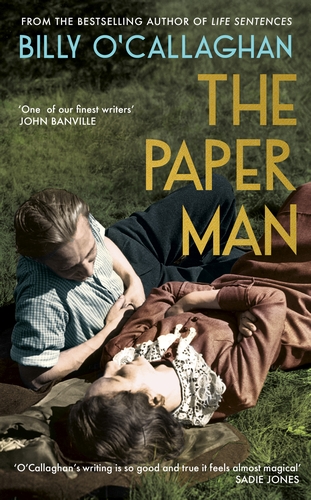
The Paper Man is not without its frustrations but shows O’Callaghan as an excellent stylist
The Paper Man|Billy O’Callaghan|Penguin|€14.99
by Eoghan Smith
It is Vienna on the eve of the Second World War and the Austrian national football team are about to play Germany in a hugely symbolic match prior to the Anschluss.
Hitler, it is rumoured, is in the crowd to watch the game. Soon Austria —and their storied team, perhaps the greatest of pre-War Europe—will cease to be. The thousands that are packed into the stadium are there to witness the last of the Wunderteam, and more specifically to watch their gifted captain and Austria’s greatest ever footballer, Matthias Sindelar, affectionately known as Der Papierene (the paper man) because of his slight build.
But when Sindelar and a woman named Camila Castagnola are found dead in bed ten months later, rumours will spread that he was murdered by the Nazis for his Jewish sympathies and refusal to play for the new unified German football team. There is some reason to believe this was the case: the Gestapo had a file on Sindelar and kept his café under surveillance.

Mystery
The mystery surrounding Sindelar’s death – it was officially reported that he died from carbon monoxide poisoning caused by a defective chimney, while others suggested he died by suicide—provides the entry point into Billy O’Callaghan’s new novel The Paper Man.
Around the established facts, O’Callaghan builds a love story between Sindelar and young Jewish waitress named Rebekah. Fearing for her safety, Rebekah is effectively sent by Sindelar to Cork, where she finds refuge among the small Jewish community there and where she soon discovers she is pregnant.
Around the established facts, O’Callaghan builds a love story between Sindelar and young Jewish waitress named Rebekah.
The story switches back and forth between two time periods: Austria between 1935 and 1938 and Cork in the 1980s. In Cork, Jack, Rebekah’s now adult son, begins a process of tracing his personal history after a discovery of newspaper clippings about the footballer and letters sent to his mother from Sindelar. Later, Jack travels to Vienna to retrace his parents’ final days.
Factual and fictional
This structure provides the novel with two intertwined narratives. The first, written in the past tense, is a retelling of Sindelar’s career as Austria’s greatest footballer, his post-retirement occupation as a café owner, and his disputed death.
The novel merges the factual and fictional in an inventive and provocative way
The second, in the present tense, is a wholly invented other life, the footballer’s romantic entanglement with a young Jewish girl, her emigration to Cork, the birth and early life of their son Jack, and the subsequent questions Jack has about his identity and origins.
The novel merges the factual and fictional in an inventive and provocative way (one can only speculate as to what Matthias Sindelar might have thought about being given a much younger girlfriend and an imaginary son with a Cork upbringing).
The Paper Man is not, however, a species of historiographical metafiction; instead, it is avowedly in the realist mode and could be described, at least in part, as a genealogical mystery novel. On the surface the novel appears much less interested in exploring the political than it is the psychological; the war exists first as a foreshadowing and then as an historical fact.
Novel of two halves
Yet The Paper Man is not without politics and there are audible contemporary echoes: the approaching war causes the agony of choice, the trauma of life-changing decisions enforced on individuals who are at the mercy of huge and terrible forces.
The Paper Man is – to employ a much-abused football cliché – a novel of two halves.
Accordingly, there is a small cast of central characters, and so history gives way to genealogy, the public to the private, the exterior to the interior. It is a mark of O’Callaghan’s skill as a writer that he can lead the reader to feel how overwhelming, catastrophic historical moments are decisively registered as intimate human traumas.
The Paper Man is – to employ a much-abused football cliché – a novel of two halves. The trouble with a genealogical mystery is that we anticipate the mystery to be, if not solved, then at least to be deepened and to open up new understandings of who we are.
Frustrations
The Paper Man is not without its frustrations because the true cause of Sindelar’s death is never fully resolved, and nor could it be, because it has never been. To be sure, O’Callaghan wants to indicate through Rebekah’s Jewishness and other plot gestures that it was most likely the work of the Nazis, and through this lens observe that the effects of history are never so remote that their reverberations cannot be felt across borders, identities and history.
…we have the nagging feeling that the best player on the pitch has been subbed off too early.
But the most interesting person in the novel, the one around whom all of the mystery centres, is the real one – Matthias Sindelar. When the novel switches attention to events after Sindelar has died, we have the nagging feeling that the best player on the pitch has been subbed off too early.
Facts can cause obstacles: the doomed and beautifully rendered romance between Sindelar, who was Catholic, and the Jewish Rebekah, which plays arpeggios on the heartstrings and is fraught with genuine jeopardy, is a little spoiled by the reality of Sindelar being found dead in a bed with Castagnola, with whom he was apparently engaged to be married. By this stage, Sindelar knows he has a son in Cork.
Complexities
Some prophylactic explanations and excuses are made for Sindelar throughout the novel for this fact; in the first flushes of their relationship, the reader picks up on Rebekah’s doubts about his fidelity while elsewhere other characters will reassure us of their mutual love.
Undoubtedly this all reinforces a sense of complexity of the human character—which one of us is perfect? For Jack, whose natural sympathies lie with his mother, it adds another layer to the mystery surrounding Sindelar—but it remains something of an emotional, even moral, conundrum that is never quite solved in the book.
Here, we suspect, is a key idea in the novel: the job of art is to show us the mystery, not to solve it.
But of course, family histories – and the wider histories of nationality, religion, and language the book touches on – are complicated, and O’Callaghan makes us feel this through Jack’s confusion and search for the meaning of it all as he researches his parents’ turbulent past.
For him, who never knew his father, just discovering who he was brings consolation. And so, like anyone tracing their family roots, Jack returns to Vienna to do his best to just get nearer to the truth, for the questions will endure.
Here, we suspect, is a key idea in the novel: the job of art is to show us the mystery, not to solve it.
Master stylist
Are the stories of Rebekah’s struggle for new life in the Jewish community in Cork and Jack’s efforts to find out about his father sufficiently interesting to withstand the departure of the novel’s central figure? They are, primarily because O’Callaghan is a master stylist and a wonderful story-teller.
His writing has the rare quality of leaving no trace of the work that has gone into it. Cascades of perfectly polished clauses tumble out evocative scenes of pre-War Viennese vibrancy, the dreariness of Cork in the 1980s.
There is great precision in O’Callaghan’s imagery, in which the reader is immersed in details of character, time and place, and every sentence manages to be both interesting in its own right and to develop the action further. The Paper Man is a fine demonstration of O’Callaghan’s excellence in prose.

Eoghan Smith is the author of The Failing Heart (Dedalus 2018). His second novel, A Provincial Death is out now with Dedalus.












